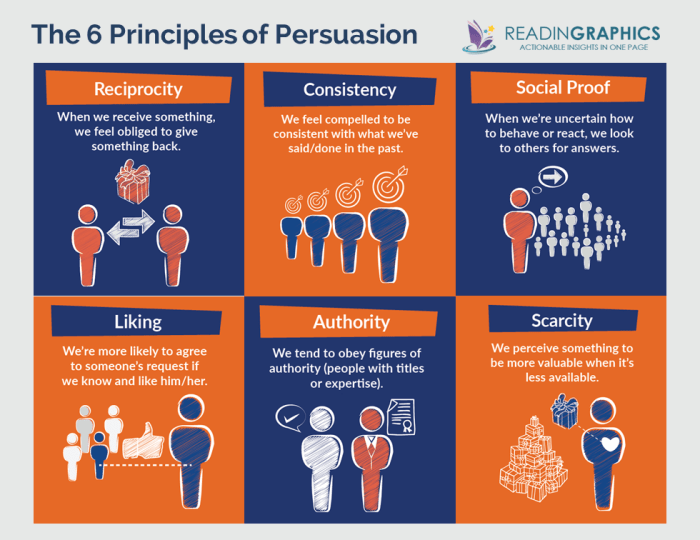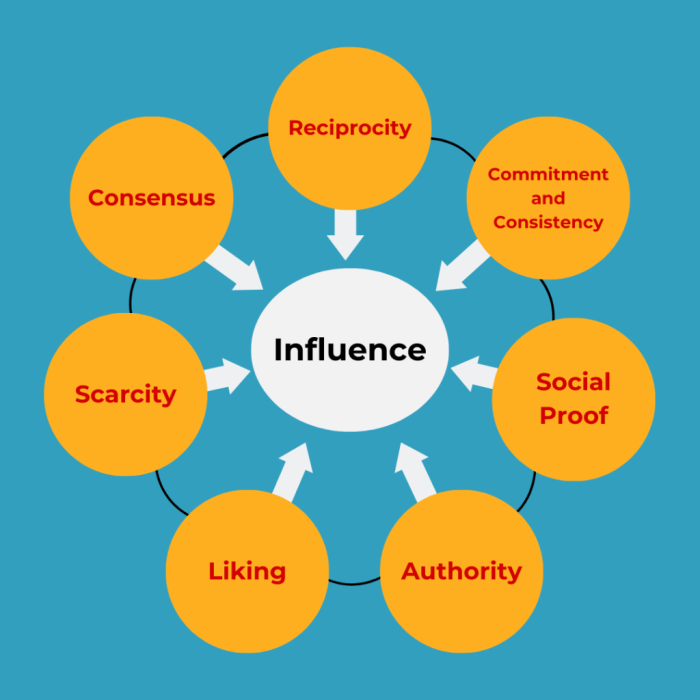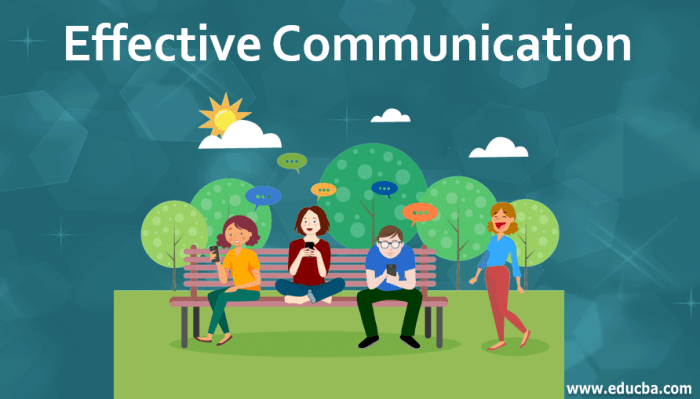Mastering the art of persuasive design is crucial in today’s competitive landscape. This guide delves into five key principles of effective communication, exploring how psychology, visual hierarchy, compelling messaging, and optimized user experience converge to influence user behavior and drive conversions. We’ll examine practical techniques, from crafting impactful calls to action to leveraging A/B testing for maximum impact, ultimately empowering you to design experiences that resonate and persuade.
Through practical examples and actionable strategies, we will unpack the nuances of persuasive design, covering everything from understanding color psychology and the power of storytelling to optimizing website layouts and user journeys. This exploration will provide a comprehensive framework for creating designs that not only attract but also convert.
Understanding Persuasive Design Principles

Persuasive design leverages psychological principles to influence user behavior, subtly guiding them towards desired actions. Understanding these principles is crucial for creating effective and ethical communication that resonates with the target audience and achieves its intended purpose. This involves a deep understanding of human psychology and how visual elements impact decision-making.
Psychological Principles Behind Effective Communication Design
Effective communication design relies on several key psychological principles. For example, the principle of reciprocity suggests that people are more likely to comply with a request if they feel they have received something in return. Similarly, the principle of scarcity highlights the importance of creating a sense of urgency or limited availability to encourage immediate action. Social proof, the tendency to follow the actions of others, is also highly influential; showcasing positive testimonials or reviews can significantly impact purchase decisions. Finally, authority figures and expert opinions hold considerable sway, adding credibility and trustworthiness to the message. These principles, when strategically applied, can significantly enhance the persuasive power of a design.
Color Psychology’s Impact on Persuasive Design
Color psychology plays a vital role in persuasive design, as different colors evoke distinct emotions and associations. For instance, blue often conveys trust and stability, making it suitable for financial institutions or healthcare providers. Red, associated with urgency and excitement, can be used effectively in sales promotions or call-to-action buttons. Green signifies growth and nature, fitting for environmentally conscious brands. Yellow evokes happiness and optimism, while black projects sophistication and elegance. However, color choices should always align with brand identity and target audience preferences to avoid unintended consequences. For example, using too much red might create anxiety instead of excitement.
Visual Hierarchy’s Role in Guiding User Attention and Influencing Choices
Visual hierarchy is the arrangement of visual elements to guide the user’s eye through the design. It dictates the order in which information is perceived and influences the user’s attention and choices. Effective visual hierarchy utilizes size, contrast, color, and whitespace to create a clear path for the user’s gaze. Larger, bolder elements command more attention, while smaller, less prominent elements recede into the background. Strategic use of whitespace creates breathing room and prevents visual clutter, enhancing readability and improving the overall user experience. A well-designed visual hierarchy ensures that crucial information, such as calls to action, is easily noticed and prioritized.
Mock Website Layout Demonstrating Effective Use of Visual Hierarchy
Imagine an e-commerce website selling handcrafted jewelry. The hero image would feature a stunning close-up of a necklace, occupying the top half of the screen. The image would be high-resolution and visually appealing. Below the image, a concise headline, “Exquisite Handcrafted Jewelry,” would be prominently displayed in a large, bold font. A brief, compelling sub-headline, “Discover unique pieces crafted with love and passion,” would follow in a slightly smaller font. A clear call-to-action button, “Shop Now,” would be positioned centrally beneath the text, using a contrasting color and a visually distinct shape. Further down, smaller sections showcasing featured collections, customer testimonials, and shipping information would be organized neatly, maintaining a clean and uncluttered layout. This layout prioritizes the most important information (the jewelry, the call to action) while providing additional information in a structured and easily accessible manner.
Comparison of Persuasive Design Techniques
The following table compares and contrasts different persuasive design techniques:
| Technique | Description | Example | Potential Drawbacks |
|---|---|---|---|
| Scarcity | Creating a sense of urgency or limited availability. | “Only 3 left in stock!” | Can feel manipulative if overused. |
| Authority | Leveraging the credibility of experts or influential figures. | “Recommended by leading dermatologists.” | Requires genuine authority; false claims can backfire. |
| Reciprocity | Offering something of value in exchange for a desired action. | “Free shipping on orders over $50.” | The offer must be genuinely valuable to be effective. |
| Social Proof | Highlighting positive reviews or testimonials. | “4.8 stars based on 1000+ reviews.” | Fake reviews can damage credibility. |
Crafting Compelling Messaging and Calls to Action

Effective communication hinges on crafting compelling messaging and calls to action (CTAs). This involves understanding your audience, clearly articulating the benefits of your product or service, and motivating them to take the desired action. The right words, strategically placed, can significantly impact conversion rates and overall campaign success.
Strong Calls to Action Across Various Mediums
Effective calls to action vary depending on the platform. A concise CTA on a website might differ significantly from one used in an email or social media post. Consider these examples:
- Website: Instead of a generic “Learn More,” try a more specific and benefit-driven CTA like “Get Your Free Consultation Now” or “Download Your Free E-book and Start Saving Today.” The immediacy and clear benefit are key.
- Email: Email CTAs should be prominent and visually distinct. Examples include “Shop Now and Get 20% Off,” “Book Your Appointment,” or “Claim Your Free Trial.” A strong sense of urgency often works well here.
- Social Media: Social media CTAs need to be short, punchy, and tailored to the platform. “Click Here to Learn More,” “Shop Now,” or “Sign Up” are effective, but always consider including relevant hashtags to increase visibility.
Clear, Concise, and Benefit-Driven Language in Persuasive Communication
Clarity and conciseness are paramount. Avoid jargon and technical terms your audience may not understand. Focus on the benefits, not just the features. Instead of saying “Our software uses advanced algorithms,” say “Our software saves you time and money by automating tedious tasks.” This highlights the tangible value proposition for the user. Benefit-driven language directly addresses the user’s needs and desires, making your message more persuasive.
The Impact of Storytelling on User Engagement and Persuasion
Storytelling connects with audiences on an emotional level, fostering trust and engagement. By sharing relatable narratives that highlight the problem your product or service solves, you create a more memorable and persuasive message. A well-crafted story can humanize your brand and build a stronger connection with your target audience. For example, a story about a customer who overcame a challenge using your product is far more impactful than a list of features.
A Step-by-Step Guide to Writing Effective Marketing Copy
Writing effective marketing copy requires a strategic approach. Here’s a step-by-step guide:
- Identify your target audience: Understanding their needs, pain points, and aspirations is crucial for crafting resonant messaging.
- Define your objective: What action do you want your audience to take? (e.g., purchase a product, sign up for a newsletter, visit a website).
- Craft a compelling headline: The headline is your first impression – make it count. It should grab attention and clearly communicate the value proposition.
- Write benefit-driven body copy: Focus on how your product or service solves the user’s problem and improves their life.
- Include a strong call to action: Make it clear, concise, and visually prominent.
- Proofread and edit: Ensure your copy is free of errors and flows smoothly.
Using Different Types of Persuasive Language in a Sample Marketing Campaign
Consider a marketing campaign for a new fitness app.
- Emotional Appeal: “Achieve your fitness goals and feel amazing! Our app provides the support and motivation you need to transform your life.” (Focuses on feelings of accomplishment and self-improvement)
- Logical Reasoning: “Our app uses scientifically proven methods to help you reach your fitness goals faster and more effectively. See results with our personalized workout plans and progress tracking.” (Highlights data and facts)
- Social Proof: “Join millions of users who have already achieved their fitness goals with our app. See their success stories and testimonials!” (Uses the influence of others to persuade)
This multi-pronged approach combines different persuasive techniques to create a more impactful and effective campaign.
Optimizing User Experience for Persuasion

Effective persuasive design hinges on a seamless and enjoyable user experience. A positive UX fosters trust, encourages engagement, and ultimately leads to higher conversion rates. Ignoring UX in favor of aggressive sales tactics often backfires, driving users away rather than attracting them. This section explores key UX elements that contribute to persuasive design and how to optimize them.
Key UX Elements Contributing to Positive User Experience and Increased Conversions
Intuitive navigation, clear calls to action, visually appealing design, and fast loading speeds are crucial for a positive user experience. A cluttered or confusing website will quickly frustrate users, leading them to abandon their task. Conversely, a well-designed website that is easy to navigate and visually appealing will keep users engaged and more likely to convert. For example, a website selling handcrafted jewelry should showcase high-quality images of the products, provide detailed descriptions, and offer easy-to-use filtering options. The checkout process should be straightforward and secure, minimizing friction points.
Comparison of Website Layouts Designed for Persuasion
Different website layouts serve different persuasive goals. A landing page focused on a single product might utilize a minimalist design with a prominent call to action, while an e-commerce website might employ a more complex layout with multiple categories and filtering options. Consider a comparison between a website using a single-column layout, emphasizing simplicity and direct messaging, versus a website employing a multi-column layout allowing for more content and visual appeal. The single-column layout is better suited for simple, direct sales pitches, while the multi-column layout offers more flexibility for showcasing diverse products or information. The optimal choice depends on the specific goals and target audience.
Examples of User Testing Improving Persuasive Design
User testing provides invaluable insights into how users interact with a website and identify areas for improvement. For instance, A/B testing two versions of a landing page, one with a prominent call to action button and another with a less prominent one, can reveal which design performs better in terms of click-through rates. Eye-tracking studies can identify which elements users focus on first, revealing areas of potential improvement. By observing users navigating the site, designers can identify friction points and areas of confusion. For example, if users repeatedly struggle to find the checkout button, the design needs to be adjusted to improve visibility and accessibility.
User Journey and Decision-Making Process Flowchart
The following flowchart illustrates a simplified user journey and decision-making process within a persuasive design context:
[Imagine a flowchart here. The flowchart would start with “User Enters Website,” branching to “Engaged/Not Engaged.” “Engaged” would lead to “Navigates Site,” then “Finds Relevant Information,” followed by “Considers Purchase,” and finally “Completes Purchase.” “Not Engaged” would lead to “Leaves Website.” Each stage could include considerations such as clear calls to action, intuitive navigation, and compelling content.]
Using A/B Testing to Optimize Elements for Maximum Persuasive Impact
A/B testing is a crucial tool for optimizing persuasive design. By comparing two versions of a webpage or element, designers can determine which version performs better based on key metrics.
The importance of A/B testing lies in its ability to provide data-driven insights, allowing for iterative improvements and optimization of the user experience. This eliminates guesswork and ensures design choices are based on user behavior rather than assumptions.
- Conversion Rate: The percentage of users who complete the desired action (e.g., purchase, sign-up).
- Click-Through Rate (CTR): The percentage of users who click on a specific element (e.g., button, link).
- Bounce Rate: The percentage of users who leave the website after viewing only one page.
- Average Session Duration: The average time users spend on the website.
- Scroll Depth: How far down the page users scroll before leaving.
Last Point

By understanding and implementing these five principles—psychological principles, compelling messaging, visual hierarchy, optimized user experience, and data-driven optimization—you can significantly enhance the persuasive power of your designs. Remember that effective persuasion is not about manipulation but about creating genuine connections with your audience and providing value. This holistic approach will ultimately lead to increased engagement, higher conversion rates, and lasting impact.